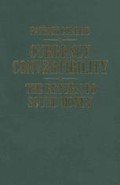Abstract
In the following a number of key points from the argument of the foregoing chapters are recapitulated and emphasised. The foundation of the case for the implementation of the particular system of conditional currency convertibility formulated by Grondona, is the argument that only the resumption of some form of currency convertibility offers the prospect of returning to monetary and economic stability. The main reasons for reconsidering the classical mechanism of currency convertibility can be summarised as follows:
-
1.
No mechanism other than currency convertibility acts directly to stabilise the real value of money, which is the fundamental objective of monetary policy, and no other mechanism has ever succeeded in preserving the value of currency in the long term. This fact bears emphasis at a time when the depreciation of money has been so rapid that on average in the major OECD countries money lost more than 60 per cent of its value in the first decade following the abandonment of gold convertibility of the US dollar in 1971.
-
2.
No mechanism other than currency convertibility exerts a dual counter-cyclical influence on both the monetary and real economies in response to changes caused by market forces in the velocity of circulation of money. The system exerts this influence by permitting the withdrawal of commodities from the market and a corresponding increase in the supply of money when the demand for money is rising relative to the demand for goods, and by permitting an increase in the supply of commodities and a corresponding withdrawal of money from circulation when the demand for goods is rising relative to the demand for money.
-
3.
No mechanism other than currency convertibility, and in particular no politically administered scheme, can bring about the same pattern of expansion and contraction of liquidity and its detailed international distribution according to market forces in a manner tending to stabilise the level of economic activity — even in theory. In practice, regardless of the intentions of governments, the unavoidable inefficiencies of the political policy-making process produce a result substantially poorer than even the best that is theoretically achievable.
Access this chapter
Tax calculation will be finalised at checkout
Purchases are for personal use only
Preview
Unable to display preview. Download preview PDF.
References
J. Tumlir, ‘The World Economy Today: Crisis or a New Beginning?’, National Westminster Bank Review, August 1983, pp. 41–2.
L. St Clare Grondona, Utilizing World Abundance, George Allen & Unwin, London, 1958.
Editorial, The Manager, Vol. 26, No. 3, March 1958.
Author information
Authors and Affiliations
Copyright information
© 1985 Patrick Collins
About this chapter
Cite this chapter
Collins, P. (1985). Epilogue. In: Currency Convertibility. Palgrave Macmillan, London. https://doi.org/10.1007/978-1-349-07058-9_10
Download citation
DOI: https://doi.org/10.1007/978-1-349-07058-9_10
Publisher Name: Palgrave Macmillan, London
Print ISBN: 978-1-349-07060-2
Online ISBN: 978-1-349-07058-9
eBook Packages: Palgrave Economics & Finance CollectionEconomics and Finance (R0)

